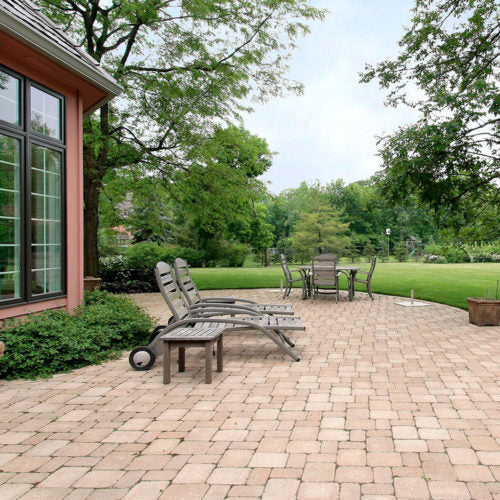If you’ve ever looked out at your garden patio and seen dark, patchy marks or greenish slime spreading across the paving, you’re not alone. These unwanted growths are incredibly common in the UK climate, especially during our wet, mild winters. But while they may all look similar at first glance, patio black spots, mould, and algae are different in both their cause and the best way to deal with them. Understanding the differences isn’t just helpful-it’s essential if we want to clean and protect our outdoor spaces properly without wasting time or money on the wrong treatment.
We’ve spent years working with stone surfaces and outdoor areas, so we’ve come to know the specific behaviours and challenges that each of these organisms present. Through this experience, we’ve developed effective solutions that don’t just treat the symptoms, but go after the root cause - quite literally in some cases. Let’s break down what makes patio black spots, mould, and algae so different from each other, and how we can respond to each effectively.
What is Black Spot on patio?
Black spots are caused by a hardy variety of lichen - tiny but stubborn organisms that bind closely with natural stone. These spots often start out small but grow deeper into the pores of the stone over time. One of the biggest frustrations is that even high-pressure washing often doesn’t remove them completely, because the root system of the lichen embeds itself far beneath the surface. That’s why we always advise against relying solely on power washers, as they can damage the stone without actually solving the issue.
What makes black spots particularly difficult is their persistence. They thrive on organic debris that builds up on patios, especially in shaded or damp areas. As we’ve seen first-hand with customers, they can remain dormant for months and then suddenly seem to worsen after rain or mild weather.
How Is Mould Different?
Mould, or mildew, is another common culprit on patios, especially in shaded areas with poor ventilation. Unlike patio black spots, mould is typically more superficial - it doesn’t have the same deep-rooted structure. You’ll often notice it grows over the winter or during periods of wet weather.
The good news is that mould is easier to clean than black spots. It doesn’t penetrate the stone in the same way, so a targeted cleaning solution and improved airflow can help prevent the problem. However, it’s worth noting that if left untreated, mould can still make surfaces slippery and pose health risks. That’s why routine maintenance is key, particularly in damp corners or where patio furniture sits for long periods.
Understanding Algae on Patios
Algae are usually the green, slippery patches that appear after wet weather. In our experience, they spread quickly, particularly on north-facing surfaces or areas near garden plants and grass. Algae require light and moisture to thrive, making UK gardens a perfect environment. While they might seem harmless at first, algae-covered surfaces can become dangerously slippery and pose a serious slip hazard.
The primary difference between algae and mould lies in their growth conditions and texture. Algae are plant-like organisms and often appear in thin sheets or streaks across the patio surface. Unlike lichen, they don’t root deeply into stone, which makes them easier to remove, although they can be stubborn if left for long periods.
Can One Product Remove Them All?
We often get asked whether a single treatment can tackle all three - black spots, mould, and algae. The short answer is: Yes. Each of these issues stems from a different type of organism and behaves differently on surfaces. Our patio cleaning service was designed to remove organic growth such as mould, mildew and algae quickly. Our treatments are specifically designed to penetrate all types of stone and break down the root systems of lichen, something most professional patio cleaners fail to do.
When it comes to mould and algae, quicker-acting, surface-level cleaners tend to be more effective. However, it’s not just about removal. Prevention plays a huge role. Regular sweeping, ensuring good drainage, and reducing organic build-up can help limit the return of these problems.
How to Prevent Future Growth
Once we’ve treated a patio, our goal is to provide long-term value for our clients. Our annual patio cleaning service is less expensive when carried out annually. This service will help prevent the return of black spots and discolouration.
Keeping the area clear of leaves and dirt, and trimming back overhanging plants, also helps to improve airflow and sunlight exposure, both natural deterrents to fungal and algal growth.
Why It Matters
Understanding the difference between patio black spots, mould, and algae helps you choose the right treatment from the start. It saves time, money, and unnecessary wear on your paving. More importantly, it helps keep outdoor spaces looking their best - and safe for everyone to walk on.
We’ve built our reputation on offering expertise in dealing with all three of these issues, with targeted solutions that protect your investment in outdoor living. By focusing on long-term prevention and deep-clean effectiveness, we support homeowners across the UK in maintaining pristine patios without harsh methods that damage stone.
To explore our full range of stone-specific treatments and maintenance guides, you can visit the services and product information found on our website. We also recommend reviewing guidance from organisations such as the RHS (Royal Horticultural Society), which provides trusted information on garden maintenance relevant to our local environment.
If you’re unsure what type of staining you’re dealing with on your patio, get in touch - we’re always happy to offer advice based on experience, not guesswork.



